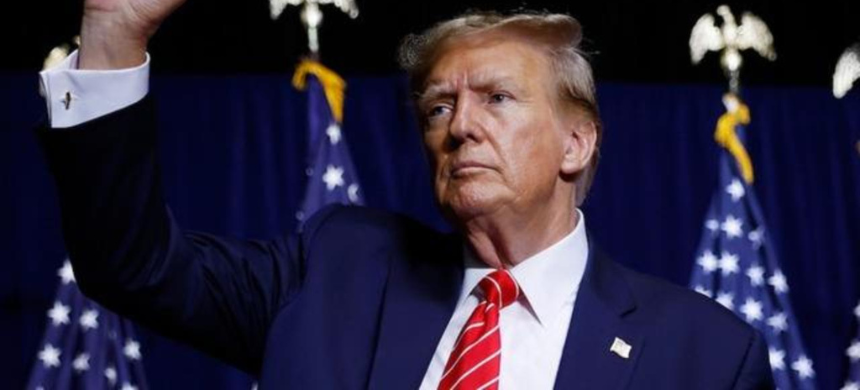U.S. President Donald Trump announced on Sunday that he will impose a new 25% tariff on all steel and aluminum imports into the country, in addition to the existing duties on metals. This move marks another significant escalation in his trade policy.
Speaking to reporters aboard Air Force One while en route to the NFL Super Bowl in New Orleans, Trump stated that he would formally announce the new tariffs on Monday. He further mentioned that reciprocal tariffs would be introduced on Tuesday or Wednesday, which would take effect almost immediately. These tariffs will apply to all countries, matching the rates imposed by each nation on U.S. goods.
“If they charge us, we charge them,” Trump explained regarding the reciprocal tariff plan.
Read More: Afghanistan reduces coal tariffs and royalties
The primary sources of U.S. steel imports include Canada, Brazil, and Mexico, followed by South Korea and Vietnam, as per government and American Iron and Steel Institute data. Canada, due to its abundant hydropower resources, remains the largest supplier of primary aluminum to the U.S., accounting for 79% of imports during the first 11 months of 2024.
Canadian Innovation Minister Francois-Philippe Champagne responded to Trump’s announcement on X, emphasizing the importance of Canadian steel and aluminum in key U.S. industries, such as defense, shipbuilding, and automotive. He reaffirmed Canada’s commitment to protecting its workers and industries.
Trump also addressed the acquisition of U.S. Steel by Japan’s Nippon Steel, stating that while investment would be permitted, a majority stake would not be allowed. “Tariffs will make [U.S. Steel] very successful again, and I think it has good management,” he added. Nippon Steel declined to comment on Trump’s statements.
Concerns Over Quotas
During his first term, Trump imposed a 25% tariff on steel and a 10% tariff on aluminum but later granted duty-free exemptions to several trading partners, including Canada, Mexico, and Brazil. Mexico is a significant supplier of aluminum scrap and alloys to the U.S.
Former President Joe Biden later renegotiated duty-free quota arrangements with Britain, the European Union, and Japan. However, it remains unclear how Trump’s latest announcement will impact these exemptions and quota agreements.
Quebec Premier Francois Legault also commented on X, pointing out that Quebec exports 2.9 million tons of aluminum to the U.S., covering 60% of its needs. He questioned whether the U.S. preferred to source its aluminum from China instead. Legault stressed the urgency of renegotiating the free trade agreement with the U.S. before the scheduled 2026 review, calling for an end to uncertainty.
Steel mill capacity utilization in the U.S. surged beyond 80% in 2019 after Trump’s initial tariffs but has since declined due to China’s dominance in the sector, which has driven steel prices lower. Meanwhile, an aluminum smelter in Missouri, revived by Trump’s tariffs, was shut down last year by Magnitude 7 Metals.
Reciprocal Tariffs and Trade Disputes
Trump announced that he would provide further details on his reciprocal tariff plan in a press conference on Tuesday or Wednesday. He initially revealed on Friday that he intended to introduce these tariffs to ensure fair trade treatment for the U.S.
A long-standing concern of Trump’s is the disparity in tariffs between the U.S. and other nations. He frequently criticizes the European Union for imposing a 10% tariff on auto imports while the U.S. only charges 2.5%. According to Trump, Europe “won’t take our cars” while exporting millions to the U.S. each year.
However, the U.S. maintains a 25% tariff on pickup trucks, a highly profitable segment for American automakers such as General Motors, Ford, and Stellantis.
Data from the World Trade Organization indicates that the U.S. has a trade-weighted average tariff rate of approximately 2.2%, whereas India’s rate is 12%, Brazil’s is 6.7%, Vietnam’s is 5.1%, and the EU’s stands at 2.7%.
Border Security and Tariffs on Mexico and Canada
In a separate interview with Fox News, Trump criticized Canada and Mexico for not taking sufficient measures to secure their borders and curb drug trafficking ahead of a March 1 tariff deadline.
He had previously threatened to impose a 25% tariff on all imports from Mexico and Canada unless stricter border security measures were implemented. Following some initial concessions—including Mexico’s commitment to deploying 10,000 National Guard troops and Canada’s investment in new security technologies and anti-fentanyl measures—Trump temporarily paused the tariffs until March 1.
When asked if the actions taken by Canada and Mexico were sufficient to prevent the tariffs, Trump firmly responded, “No, it’s not good enough. Something has to happen, it’s not sustainable, and I’m changing it.”
However, he did not specify what additional steps Canada and Mexico must take to avoid the implementation of broad tariffs on March 1.











